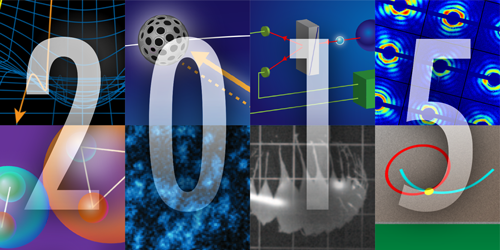 精选
精选
美国物理学会(APS)评选出2015年物理学标志性进展(Highlights of the Year) https://physics.aps.org/articles/v8/126
共八项,其中中国物理学家主要贡献了一项,次要贡献两项。

1,Death Knell for Local Realism (定域实在性的丧钟)
贡献者:美国、奥地利,荷兰的三个实验小组( NIST in Boulder, Colorado, and at the University of Vienna, Austria, Delft University of Technology, Netherlands)
这个领域的开拓者Alain Aspect在美国物理学会电子刊物Physics观点栏目的评述文章中提到段路明教授的如下工作:[28]. L.-M. Duan, M. D. Lukin, J. I. Cirac, and P. Zoller, “Long-Distance Quantum Communication with Atomic Ensembles and Linear Optics,” Nature 414, 413 (2001).
2, Particle High Five (找到五夸克态)
贡献者:欧洲大型强子对撞机合作组(LHCb),含清华大学高能物理中心,华中师范大学粒子物理研究所
Center for High Energy Physics, Tsinghua University, Beijing, China; Institute of Particle Physics, Central China Normal University, Wuhan
3,3D X-ray Images of a Single Virus (单个病毒的三维X射线图像)
贡献者:美国直线加速器中心(Stanford Linear Accelerator Center,SLAC)
4,Warped View of Dark Matter (暗物资的乖戾观)
贡献者:暗能量巡天合作组(Dark Energy Survey (DES) in Chile)
5,Discovery of Weyl Semimetals (发现外尔半金属)
贡献者:由普林斯顿大学和中科院物理所研究小组分别发现
“Two teams, one led by Zahid Hasan of Princeton University, New Jersey [2], and the other by Hong Ding of the Chinese Academy of Sciences in Beijing [3], discovered …”
[2] S.-Y. Xu et al., “Discovery of a Weyl Fermion Semimetal and Topological Fermi Arcs,” Science 349, 613 (2015).
[3] B. Q. Lv et al., “Experimental Discovery of Weyl Semimetal TaAs,” Phys. Rev. X 5, 031013 (2015).
美国物理学会电子刊物Physics观点栏目的评述文章中另外引用了戴希教授小组的理论工作
[11]H. Weng, C. Fang, Z. Fang, B. Andrei Bernevig,and X. Dai, “Weyl Semimetal Phase in Noncentrosymmetric Transition-Metal Monophosphides,” Phys. Rev. X 5,011029 (2015).
6,Qubits in Space (空间中的量子比特)
贡献者:两个意大利研究小组:University of Padua and the Matera Laser Ranging Observatory, both in Italy.
7,Zooming in on Fermions (费米子中有乾坤)
贡献者:MIT,哈佛和英国Strathclyde大学研究小组(Massachusetts Institute of Technology, one at Harvard University, and one at the Universityof Strathclyde,UK)
8,Slo-Mo Videos Explain Balloon Popping Patterns (高速摄影解释气球如何爆裂)
贡献者:巴黎高师
____________
延展阅读
相关专题:2015科研精萃之十大盘点
转载本文请联系原作者获取授权,同时请注明本文来自刘全慧科学网博客。
链接地址:https://wap.sciencenet.cn/blog-3377-945072.html?mobile=1
收藏


